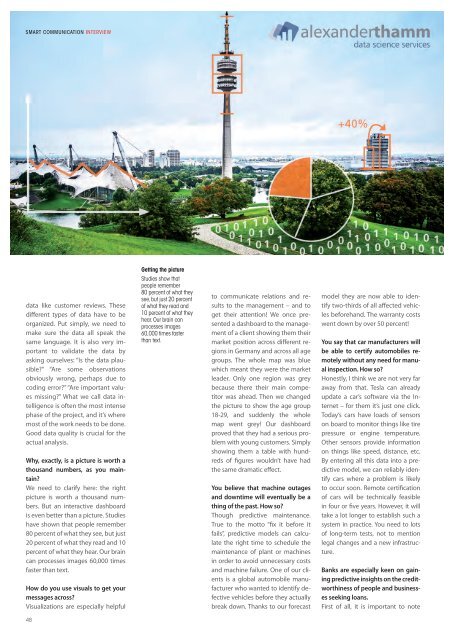Smart Industry 1/2016
Smart Industry 1/2016 - The IoT Business Magazine - powered by Avnet Silica
Smart Industry 1/2016 - The IoT Business Magazine - powered by Avnet Silica
Create successful ePaper yourself
Turn your PDF publications into a flip-book with our unique Google optimized e-Paper software.
SMART COMMUNICATION INTERVIEW<br />
Getting the picture<br />
Studies show that<br />
people remember<br />
80 percent of what they<br />
see, but just 20 percent<br />
of what they read and<br />
10 percent of what they<br />
hear. Our brain can<br />
processes images<br />
60,000 times faster<br />
than text.<br />
data like customer reviews. These<br />
different types of data have to be<br />
organized. Put simply, we need to<br />
make sure the data all speak the<br />
same language. It is also very important<br />
to validate the data by<br />
asking ourselves: “Is the data plausible?”<br />
“Are some observations<br />
obviously wrong, perhaps due to<br />
coding error?” “Are important values<br />
missing?” What we call data intelligence<br />
is often the most intense<br />
phase of the project, and it’s where<br />
most of the work needs to be done.<br />
Good data quality is crucial for the<br />
actual analysis.<br />
Why, exactly, is a picture is worth a<br />
thousand numbers, as you maintain?<br />
We need to clarify here: the right<br />
picture is worth a thousand numbers.<br />
But an interactive dashboard<br />
is even better than a picture. Studies<br />
have shown that people remember<br />
80 percent of what they see, but just<br />
20 percent of what they read and 10<br />
percent of what they hear. Our brain<br />
can processes images 60,000 times<br />
faster than text.<br />
How do you use visuals to get your<br />
messages across?<br />
Visualizations are especially helpful<br />
to communicate relations and results<br />
to the management – and to<br />
get their attention! We once presented<br />
a dashboard to the management<br />
of a client showing them their<br />
market position across different regions<br />
in Germany and across all age<br />
groups. The whole map was blue<br />
which meant they were the market<br />
leader. Only one region was grey<br />
because there their main competitor<br />
was ahead. Then we changed<br />
the picture to show the age group<br />
18-29, and suddenly the whole<br />
map went grey! Our dashboard<br />
proved that they had a serious problem<br />
with young customers. Simply<br />
showing them a table with hundreds<br />
of figures wouldn’t have had<br />
the same dramatic effect.<br />
You believe that machine outages<br />
and downtime will eventually be a<br />
thing of the past. How so?<br />
Though predictive maintenance.<br />
True to the motto “fix it before it<br />
fails”, predictive models can calculate<br />
the right time to schedule the<br />
maintenance of plant or machines<br />
in order to avoid unnecessary costs<br />
and machine failure. One of our clients<br />
is a global automobile manufacturer<br />
who wanted to identify defective<br />
vehicles before they actually<br />
break down. Thanks to our forecast<br />
model they are now able to identify<br />
two-thirds of all affected vehicles<br />
beforehand. The warranty costs<br />
went down by over 50 percent!<br />
You say that car manufacturers will<br />
be able to certify automobiles remotely<br />
without any need for manual<br />
inspection. How so?<br />
Honestly, I think we are not very far<br />
away from that. Tesla can already<br />
update a car’s software via the Internet<br />
– for them it’s just one click.<br />
Today’s cars have loads of sensors<br />
on board to monitor things like tire<br />
pressure or engine temperature.<br />
Other sensors provide information<br />
on things like speed, distance, etc.<br />
By entering all this data into a predictive<br />
model, we can reliably identify<br />
cars where a problem is likely<br />
to occur soon. Remote certification<br />
of cars will be technically feasible<br />
in four or five years. However, it will<br />
take a lot longer to establish such a<br />
system in practice. You need to lots<br />
of long-term tests, not to mention<br />
legal changes and a new infrastructure.<br />
Banks are especially keen on gaining<br />
predictive insights on the creditworthiness<br />
of people and businesses<br />
seeking loans.<br />
First of all, it is important to note<br />
48

















